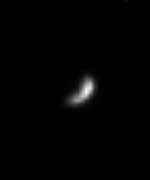With eyes sharper than any that have peered at Saturn before, the Cassini spacecraft has uncovered two moons, which may be the smallest bodies so far seen around the ringed planet.
The moons are approximately 3 kilometers (2 miles) and 4 kilometers (2.5 miles) across — smaller than the city of Boulder, Colorado. The moons, located 194,000 kilometers (120,000 miles) and 211,000 kilometers (131,000 miles) from the planet’s center, are between the orbits of two other saturnian moons, Mimas and Enceladus. They are provisionally named S/2004 S1 and S/2004 S2. One of them, S/2004 S1, may be an object spotted in a single image taken by NASA’s Voyager spacecraft 23 years ago, called at that time S/1981 S14.
“One of our major objectives in returning to Saturn was to survey the entire system for new bodies,” said Dr. Carolyn Porco, imaging team leader, Space Science Institute, Boulder, Colo. Porco planned the imaging sequences. “So, it’s really gratifying to know that among all the other fantastic discoveries we will make over the next four years, we can now add the confirmation of two new moons, skipping unnoticed around Saturn for billions of years until just now.”
The moons were first seen by Dr. Sebastien Charnoz, a planetary dynamicist working with Dr. Andre Brahic, imaging team member at the University of Paris. “Discovering these faint satellites was an exciting experience, especially the feeling of being the first person to see a new body of our solar system,” said Charnoz. “I had looked for such objects for weeks while at my office in Paris, but it was only once on holiday, using my laptop, that my code eventually detected them. This tells me I should take more holidays.”
The smallest previously known moons around Saturn are about 20 kilometers (12 miles) across. Scientists expected that moons as small as S/2004 S1 and S/2004 S2 might be found within gaps in the rings and perhaps near the F ring, so they were surprised these small bodies are between two major moons. Small comets careening around the outer solar system would be expected to collide with small moons and break them to bits. The fact that these moons exist where they do might provide limits on the number of small comets in the outer solar system, a quantity essential for understanding the Kuiper Belt of comets beyond Neptune, and the cratering histories of the moons of the giant planets.
“A comet striking an inner moon of Saturn moves many times faster than a speeding bullet,” said Dr. Luke Dones, an imaging team member from the Southwest Research Institute in Boulder, Colo. “If small, house-sized comets are common, these moons should have been blown apart many times by cometary impacts during the history of the solar system. The disrupted moon would form a ring, and then most of the material would eventually gather back together into a moon. However, if small comets are rare, as they seem to be in the Jupiter system, the new moons might have survived since the early days of the solar system.”
Moons surrounding the giant planets generally are not found where they originally formed because tidal forces from the planet can cause them to drift from their original locations. In drifting, they may sweep through locations where other moons disturb them, making their orbits eccentric or inclined relative to the planet’s equator. One of the new moons might have undergone such an evolution.
Upcoming imaging sequences will scour the gaps in Saturn’s rings in search of moons believed to be there. Meanwhile, Cassini scientists are eager to get a closer look, if at all possible, at their new finds. Porco said, “We are at this very moment looking to see what the best times are for retargeting. Hopefully, we haven’t seen the last of them.”
The Cassini-Huygens mission is a cooperative project of NASA, the European Space Agency and the Italian Space Agency. The Jet Propulsion Laboratory, a division of the California Institute of Technology in Pasadena, manages the Cassini-Huygens mission for NASA’s Science Mission Directorate, Washington, D.C. The Cassini orbiter and its two onboard cameras were designed, developed and assembled at JPL. The imaging team is based at the Space Science Institute, Boulder, Colo.
For more information about the Cassini-Huygens mission, visit http://saturn.jpl.nasa.gov and the Cassini imaging team home page, http://ciclops.org.
Original Source: NASA/JPL News Release

